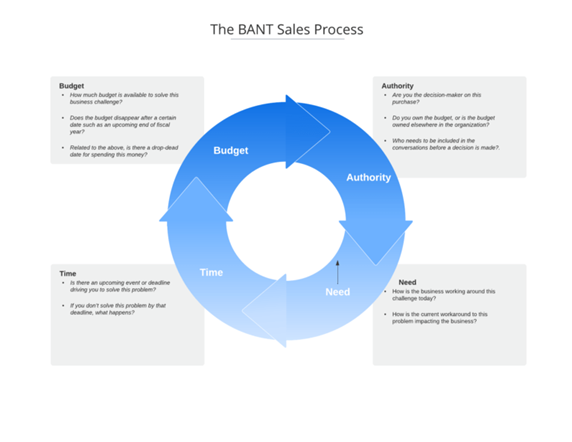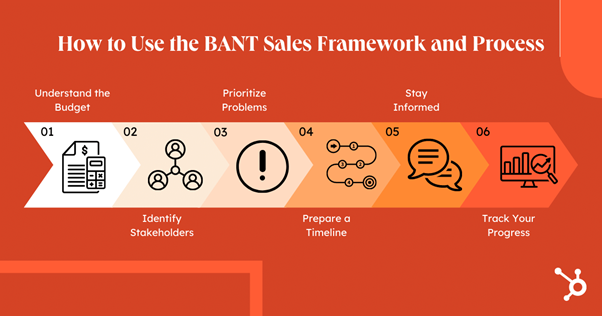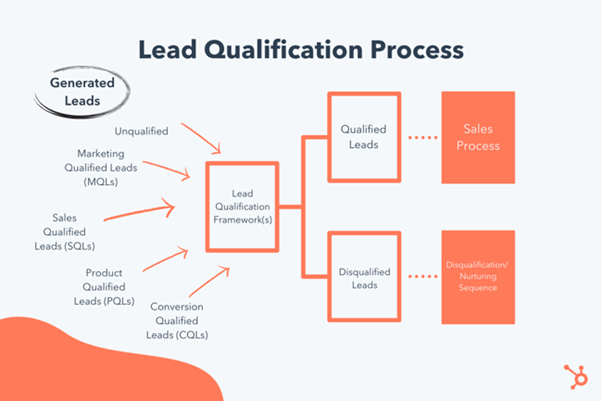Are you tired of wasting time and resources on unqualified leads? Wish there was a way to identify your ideal prospects and prioritize them for a follow-up? Look no further than the BANT framework - a proven methodology for qualifying leads in sales. By asking the right questions, you can quickly determine whether a prospect is worth pursuing further.
The BANT framework is a popular sales process used by many successful sales professionals and organizations. As the framework is based on four key factors: Budget, Authority, Need, and Timeline, the BANT framework is a helpful tool for sales professionals to determine whether a prospect is a good fit for their product or service. It is a sales qualification process that helps salespeople in focusing on prospects with the highest conversion potential.

This qualification process provides an easy framework for identifying and qualifying prospects obtained from B2B lead generation strategies. They may choose strategically which leads to pursuing first, which helps them save time and improves their close rate. BANT framework with ideal customer profile description helps in performing predictive analysis and forecasting.
In this blog post, we'll define BANT sales meaning, why it works, and how to use it effectively in your own business. Get ready to streamline your sales process and see better results!
What is BANT?
The BANT framework is a tool that salespeople can use to qualify prospects. BANT is a great way to outline the resources and requirements necessary to make a sale.BANT sales meaning extends to a list of the Budget, Authority, Need, and Timing that should be explored in order to successfully close a deal.

Breaking down the process into these four parts can help sales teams determine quickly if a client is a viable prospect. For example, if you are selling a project management tool, asking questions about these four areas can help you to determine whether or not the prospect is a good fit for your automation platform.
Budget: Does the prospect have the budget to purchase your product or service?
Authority: Is the prospect the decision-maker or the stakeholder in their organization?
Need: Does the prospect have a need for your product or service?
Timeframe: When does the prospect need your product or service?
Asking questions about Budget, Authority, Need, and Timeframe can help you quickly qualify (or disqualify) prospects. If you're able to determine that a prospect meets all of the criteria in the BANT framework, then they are likely a good fit for your product or service.
How BANT Sales Qualification framework unique?
By qualifying prospects using the BANT framework, salespeople can save time and increase their chances of making a sale. The BANT framework is a unique sales qualification framework that helps sales professionals to ask the right questions to decision-makers and successfully qualify prospects.
Without a sales qualification framework such as BANT or MEDDICC, the sales team could only guess the probability of conversion and would remain directionless to push the prospect down the funnel.

Focusing on the BANT leads that have a good fit with the product or service, instead of just any prospect, helps sales reps make the most out of their time and resources. By using the BANT framework, salespeople can quickly and accurately identify those prospects that are most likely to benefit from their product or service.
Budget: can they afford your solution?
It's crucial to take a client's budget into account while assessing them. Can they afford your proposed solution? Does this lead have the funds to purchase the product or services you are providing? If not, they probably won't work out well.
There are a few ways to determine this. The first is interrogation where you simply ask them what their budget is for this project. This can be done during the initial conversation or later on in the process. So, when should you inquire about your prospects' budget? Data shows that when pricing is discussed on the first call, win rates increase by 10%.
Another way to gauge someone's budget is to look at the scope of the project and the quantifiable goals they are trying to achieve. If it's a large project, it's likely that they have a larger budget. Conversely, if it's a small project, they may not have as much money to work with.
You can also get an idea of someone's budget by looking at similar projects you've done in the past. If you know how much those projects cost, you can use that information to estimate the budget for this potential client.
If you're looking to discuss budgeting with someone, the BANT framework can be a useful tool. BANT is a tried and tested intelligence framework for broaching budgeting conversations. Here are a few tips to help you get the conversation started:
1. Ask open-ended questions such as “What were you planning on spending for ________?”
2. Inquire about the budgeted amount for the project.
3. Find out the goal or target for the project, part, item, etc.
4. Ask how they typically go about forecasting their budget for projects etc.
Finally, you can ask if there is anything you're unsure about. It's better to get all the information upfront so that there are no surprises later on.
Authority: are they a decision-maker?
It is critical to know what you’re trying to sell and who the ultimate decision-makers are within the organization. The leads could be generated from B2B account-based marketing or event marketing but these leads must be some authorities of the company who have the power of decision-making. This way you may anticipate an honest reaction when speaking to the decision-makers or stakeholders which could shorten your sales cycle and save resources.
According to data, more than 80% of sales that fail or delay happen without access to the economic buyer or authority. Comparatively speaking, approximately 80% of agreements are won when there is strong engagement from the economic buyer as predicted.
If you’re selling a low-cost item communications and closures can happen with approval from a direct supervisor, and here the person you’re speaking to can make the buying decision without involving anyone else. However, the person you're communicating with might not have the authority to make the ultimate buying decision and seek authorization from higher authorities if you're selling a high-priced product or service that will need clearance from multiple other departments within the corporation.
Economic Buyers or Authorities are typically the ones to whom the total budget is assigned. Success will come from figuring out what they need, working with them on that, and showing them how your solution meets those needs. They only speak business, they have broad discretion over funds and an in-depth understanding of available budgets. The Economic Buyer will speak in terms similar to those used in the company's annual report. They are equipped with the information, viewpoint, comprehension, and energy necessary to make an important buying decision.
So, how do you determine whether or not someone has the authority to make a buying decision?
Here are a few questions you can ask:
- Who else needs to be involved in this decision?
- Who needs to sign off on this purchase?
Needs: does your solution address their needs?
When evaluating whether a solution addresses the needs of prospects, it's important to consider the specific needs of each prospect in the process. Finding out more about your target audience's needs and wants requires thorough research, so check for discussion boards and surveys.
It's crucial for marketers to consider how to better engage and serve their target audiences. Need assessment helps in creating highly customized, aesthetically appealing, and customer-centric content marketing strategies that address their pain points and keep them informed and engaged.
Whether it's ToFu, MoFu, or BoFu content, it needs to be relevant, high-quality, engaging, and buyer-centric. Your content marketing and syndication strategy must focus on producing content that meets the needs of your target market during their buying journey.
Need and authority go hand in hand when qualifying a lead, so as you advance in the sales process, keep coming back to the following two standards. You should double-check that:
Everyone is in agreement about the team's or company's priorities, and the issues your product or service addresses are pertinent to the tasks for which the prospect is specifically accountable.
- Learn what problems your potential client is attempting to solve. Don't waste time trying to persuade them that your product or service is a solid and workable answer.
- Determine the trigger. What kept them from seeking a solution earlier? Understanding this will enable you to gauge the scope of their issue and the urgency with which they seek to purchase a solution.
- What is the prioritization scale of their need to be solved? They are aware that failing to meet a need could have detrimental implications on the business, its clients, its staff, or its bottom line. Ask them whether they have the choice of doing nothing. This reveals their mindset and gives your salesperson clarity on whether to persuade or not.
By asking these questions on need you can get a better understanding of whether or not your solution is a good fit for the prospect. If you're able to answer all your questions positively, then you can move forward with confidence that you're addressing the
needs of your prospect.
Timeline: when do they plan to make a purchase?
Asking your prospect about their timeline for making a deal is an important part of the BANT framework. This question will help you determine if they are ready to buy now or if they are just researching an alternative and are not ready to make a deal yet. Timing is everything when it comes to sales, so knowing when your prospect plans to make a purchase is crucial in order to successfully close the deal.
A timeline helps in establishing clear priorities and instructions so that the most important tasks are completed first. Tom's Planner is one of the digital tools for project management and creating timelines. Once you create a template, moving items around is simple, and quick for appointment settings and follow-ups. For instance, completing the initial draft of the job by the scheduled time will provide you and your client enough time to complete any necessary modifications.
In the face of delays and a lack of urgency, a timeline is a great methodology to bind your prospect to the calendar and speed up your sales process. A timeline outlines the steps that must be completed in order to take advantage of the projected future value of your service.
A timeline outlines the steps that must be completed in order to take advantage of the projected future value of your service. Concentrate on the setup, implementation, and wrap-up phases in your timeline. The steps are easily separated into a logical beginning, middle, and end in this presentation, making it the ideal manner to convey the process.
This enables your prospect to visualize the process and provides them with a sense of what will be expected of them. When the time comes to turn the idea into reality, people will feel a lot more at ease if they can see it first. Timelines are easy to propose to your prospect; they will almost always be eager to receive them.
Conclusion
As a salesperson, it's important to understand your buyer and effectively qualify them using the BANT framework. By asking the right questions and gathering reliable insights about their business needs, budget requirements, authority, and the timeline for purchase decisions you can develop successful customer relationships while saving time in the process. The BANT framework is an invaluable tool and S2W Media has helped clients improve their sales by converting prospects into actual sales with its expertise in the BANT qualification process.
We can help accelerate your sales cycle and ensure that prospects with buying power convert into real clients.
_MI-Jul-21-2025-12-13-09-4578-PM.jpg?width=1600&height=1000&name=6410533984a06e54df1ab296_MicrosoftTeams-image%20(129)_MI-Jul-21-2025-12-13-09-4578-PM.jpg)

_MI-Jul-21-2025-12-05-24-8609-PM.png?width=390&height=195&name=63dbb9e116846d3e66f58437_MicrosoftTeams-image%20(119)_MI-Jul-21-2025-12-05-24-8609-PM.png)
